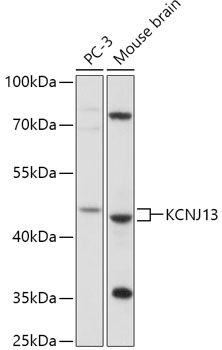Cell Biology Antibodies 13
Anti-KCNJ13 Antibody (CAB17504)
- SKU:
- CAB17504
- Product Type:
- Antibody
- Reactivity:
- Human
- Reactivity:
- Mouse
- Host Species:
- Rabbit
- Isotype:
- IgG
- Antibody Type:
- Polyclonal Antibody
- Research Area:
- Cell Biology
Description
| Antibody Name: | Anti-KCNJ13 Antibody |
| Antibody SKU: | CAB17504 |
| Antibody Size: | 20uL, 50uL, 100uL |
| Application: | WB |
| Reactivity: | Human, Mouse |
| Host Species: | Rabbit |
| Immunogen: | Recombinant fusion protein containing a sequence corresponding to amino acids 160-360 of human KCNJ13 (NP_002233.2). |
| Application: | WB |
| Recommended Dilution: | WB 1:500 - 1:2000 |
| Reactivity: | Human, Mouse |
| Positive Samples: | PC-3, Mouse brain |
| Immunogen: | Recombinant fusion protein containing a sequence corresponding to amino acids 160-360 of human KCNJ13 (NP_002233.2). |
| Purification Method: | Affinity purification |
| Storage Buffer: | Store at -20°C. Avoid freeze / thaw cycles. Buffer: PBS with 0.02% sodium azide, 50% glycerol, pH7.3. |
| Isotype: | IgG |
| Sequence: | IARP KNRA FSIR FTDT AVVA HMDG KPNL IFQV ANTR PSPL TSVR VSAV LYQE RENG KLYQ TSVD FHLD GISS DECP FFIF PLTY YHSI TPSS PLAT LLQH ENPS HFEL VVFL SAMQ EGTG EICQ RRTS YLPS EIML HHCF ASLL TRGS KGEY QIKM ENFD KTVP EFPT PLVS KSPN RTDL DIHI NGQS IDNF QISE TGLT E |
| Gene ID: | 3769 |
| Uniprot: | O60928 |
| Cellular Location: | |
| Calculated MW: | 10kDa/40kDa |
| Observed MW: | 45kDa |
| Synonyms: | KCNJ13, KIR1.4, KIR7.1, LCA16, SVD |
| Background: | This gene encodes a member of the inwardly rectifying potassium channel family of proteins. Members of this family form ion channel pores that allow potassium ions to pass into a cell. The encoded protein belongs to a subfamily of low signal channel conductance proteins that have a low dependence on potassium concentration. Mutations in this gene are associated with snowflake vitreoretinal degeneration. Alternate splicing results in multiple transcript variants.[provided by RefSeq, Feb 2010] |
| UniProt Protein Function: | KCNJ13: Inward rectifier potassium channels are characterized by a greater tendency to allow potassium to flow into the cell rather than out of it. Their voltage dependence is regulated by the concentration of extracellular potassium; as external potassium is raised, the voltage range of the channel opening shifts to more positive voltages. The inward rectification is mainly due to the blockage of outward current by internal magnesium. KCNJ13 has a very low single channel conductance, low sensitivity to block by external barium and cesium, and no dependence of its inward rectification properties on the internal blocking particle magnesium. Defects in KCNJ13 are the cause of snowflake vitreoretinal degeneration (SVD). SVD is a developmental and progressive hereditary eye disorder that affects multiple tissues within the eye. Diagnostic features of SVD include fibrillar degeneration of the vitreous humor, early-onset cataract, minute crystalline deposits in the neurosensory retina, and retinal detachment. Defects in KCNJ13 are the cause of Leber congenital amaurosis type 16 (LCA16). LCA16 is a severe dystrophy of the retina, typically becoming evident in the first years of life. Visual function is usually poor and often accompanied by nystagmus, sluggish or near-absent pupillary responses, photophobia, high hyperopia and keratoconus. Belongs to the inward rectifier-type potassium channel (TC 1.A.2.1) family. KCNJ13 subfamily. 2 isoforms of the human protein are produced by alternative splicing. |
| UniProt Protein Details: | Protein type:Membrane protein, integral; Channel, potassium; Membrane protein, multi-pass Chromosomal Location of Human Ortholog: 2q37 Cellular Component: integral to plasma membrane Molecular Function:inward rectifier potassium channel activity Biological Process: potassium ion import Disease: Leber Congenital Amaurosis 16; Vitreoretinal Degeneration, Snowflake Type |
| NCBI Summary: | This gene encodes a member of the inwardly rectifying potassium channel family of proteins. Members of this family form ion channel pores that allow potassium ions to pass into a cell. The encoded protein belongs to a subfamily of low signal channel conductance proteins that have a low dependence on potassium concentration. Mutations in this gene are associated with snowflake vitreoretinal degeneration. Alternate splicing results in multiple transcript variants.[provided by RefSeq, Feb 2010] |
| UniProt Code: | O60928 |
| NCBI GenInfo Identifier: | 13878543 |
| NCBI Gene ID: | 3769 |
| NCBI Accession: | O60928.1 |
| UniProt Secondary Accession: | O60928,O76023, Q53SA1, Q8N3Y4, A0PGH1, |
| UniProt Related Accession: | O60928 |
| Molecular Weight: | 10,980 Da |
| NCBI Full Name: | Inward rectifier potassium channel 13 |
| NCBI Synonym Full Names: | potassium voltage-gated channel subfamily J member 13 |
| NCBI Official Symbol: | KCNJ13 |
| NCBI Official Synonym Symbols: | SVD; LCA16; KIR1.4; KIR7.1 |
| NCBI Protein Information: | inward rectifier potassium channel 13 |
| UniProt Protein Name: | Inward rectifier potassium channel 13 |
| UniProt Synonym Protein Names: | Inward rectifier K(+) channel Kir7.1; Potassium channel, inwardly rectifying subfamily J member 13 |
| Protein Family: | Inward rectifier potassium channel |
| UniProt Gene Name: | KCNJ13 |
| UniProt Entry Name: | KCJ13_HUMAN |







